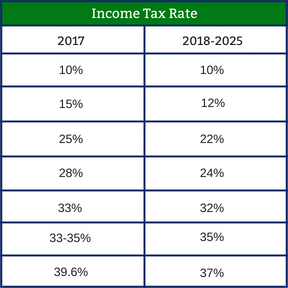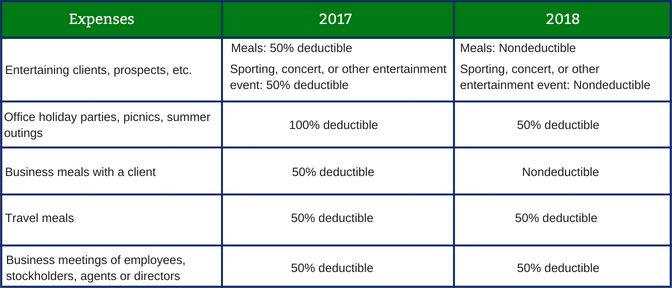
The Tax Cuts and Jobs Act (TCJA) is now in full force and has made significant changes to the U.S. tax code for both individuals and businesses since it was signed by President Trump on December 22, 2017. Though we’ve been living with the major reform for several months, the uncertainty surrounding the changes and their effects are still highly prevalent. We’ve put together a guide comparing the new and old laws of the top 8 provisions to help flesh out the uncertainty of the reform and to help you understand how the TCJA could impact your take-home pay and tax refund this year.
[Related Article: New Federal Law Brings Changes to Business Taxes]
1. Individual Tax Rates
The TCJA has kept the seven-bracket structure, however, the income tax rates have decreased. Comparable rates are as follows:

2. Individual Alternative Minimum Tax
Old: The AMT exemption amount was $54,300 for single filers and $84,500 for married taxpayers filing jointly.
New: The AMT exemption amounts increased to $70,300 for single filers and $109,400 for married taxpayers filing jointly.
3. Standard Deduction & Personal Exemptions
A standard deduction is the portion of income that is not subject to tax and can be used to reduce a taxpayer’s tax bill. A personal exemption is the amount taxpayers can deduct from their income for every taxpayer and most dependents claimed on their return.
Old: Single taxpayers were allowed a standard deduction of $6,350 and $12,700 for married taxpayers filing jointly. Personal exemptions of $4,050 were allowed for each family member.
New: Single taxpayers are allowed a standard deduction of $12,000 and $24,000 for married taxpayers filing jointly. Personal exemptions are repealed.
4. Individual State and Local Tax Deductions
Old: Taxpayers who itemize deductions on their federal income tax returns can deduct state and local income taxes and real estate taxes without a cap.
New: State and local income and real estate tax deductions have been capped at $10,000 combined.
5. Mortgage Interest Deduction
Old: Mortgage interest paid on your first and second homes were deductible for loans totaling $1 million or less. Home equity interest paid on your first and second homes were deductible for loans totaling $100,000 or less, regardless of how the proceeds were spent.
New: Mortgage interest paid on your first and second homes are deductible for loans totaling $750,000 or less. Home equity loan interest paid on your first and second homes are deductible for loans totaling $100,000, however, loan proceeds must be used to acquire or improve your first or second home to be deductible.
6. Corporate Tax Rates & Corporate Alternative Minimum Tax (AMT)
Old: Corporate tax rates ranged from a minimum of 15% to a maximum of 35%. Corporations may have been subject to corporate AMT.
New: The new corporate tax rates are set at 21%, and the corporate AMT has been repealed.
7. Pass-Through Deduction
Old: Pass-through businesses, which include sole proprietorships, S corporations, master limited partnerships (MLP), limited liability partnerships (LLP) and limited liability companies (LLC), don’t pay income taxes at the corporate level. Instead, the owners pay individual income taxes on their share of business income.
New: Pass-through business owners are eligible to take a deduction totaling 20% of their business net income. The size of the deduction varies depending on the nature of the business activity and the total income of its owner.
8. Meals and Entertainment Expenses
The TCJA has placed stricter limits on the deductibility of business entertainment and meal expenses. The chart below outlines just a few of the many expenses impacted by the reform.

Though we covered the top 8 provisions, there are still many changes included in the TCJA that may impact your individual or business taxes. Also note that the business tax reforms are permanent, while the individual tax reforms will expire in 2025.
Are you curious how the TCJA will impact your taxes this year? Give us a call or send us an email, we would be happy to help!

Recent Comments